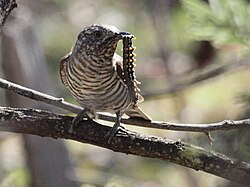| Shining bronze cuckoo | |
|---|---|
 | |
| In NSW, Australia | |
| Scientific classification | |
| Kingdom: | Animalia |
| Phylum: | Chordata |
| Class: | Aves |
| Order: | Cuculiformes |
| Family: | Cuculidae |
| Genus: | Chalcites |
| Species: | C. lucidus |
| Binomial name | |
| Chalcites lucidus (Gmelin, 1788) | |
| Synonyms | |
Chrysococcyx lucidus | |
The shining bronze cuckoo (Chalcites lucidus) is a species of cuckoo in the family Cuculidae, found in Australia, Indonesia, New Caledonia, New Zealand, Papua New Guinea, Solomon Islands, and Vanuatu. It was formerly placed in the genus Chrysococcyx .
Contents
- Taxonomy
- Description
- Distribution and habitat
- Behaviour and ecology
- Breeding
- Food and feeding
- Predators and threats
- References
- Sources
- External links
It is a very small cuckoo, being only 13 to 18 cm (5.1 to 7.1 in) in length, and parasitises chiefly dome-shaped nests of various Gerygone species, having a range that largely corresponds with the distribution of that genus. It may also parasitise other Acanthizidae species, and is also the most southerly ranging brood parasitic bird species in the world, extending to at least 46°S in New Zealand.






